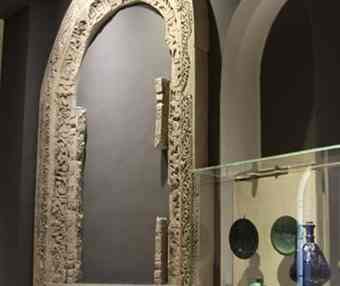Egyptian Minister of Culture, Farouk Hosni and former Secretary General of The Supreme Council of Antiquities, Dr Farouk Hosni went on a tour of the archaeological Museum of Islamic Art (MIA) at Bab El-Khalq area, to inspect the progress of the latest restoration projects.
 Several years ago the MIA was closed for comprehensive rehabilitation, not only of its building and interior design, but also of its exhibition design and displays. Over the last six years, massive renovation work has been completed to the tune of LE90 million.
Several years ago the MIA was closed for comprehensive rehabilitation, not only of its building and interior design, but also of its exhibition design and displays. Over the last six years, massive renovation work has been completed to the tune of LE90 million.
The MIA first opened in 1881 in the arcades of the mosque of the Fatimid Caliph Al-Hakim, displaying 111 objects gathered from mosques and mausoleums across Egypt.
Due to the rapid increase in size of the collection, a new building was constructed in the courtyard of the mosque in 1883. In 1899, the government began the construction on the present building at Bab El-Khalq, and in 1903 the Islamic Museum opened with a collection of 3,154 objects originating from Egypt and other countries.
Since its inception, the museum had never once been renovated, except for an attempt to clean the walls and renovate the displays in 1983. Attempts at a more comprehensive renovation were frustrated in part by the building's upper floor being occupied by a separate institution, the Dar Al-Kotob Al-Masreya.
In 2003, the Ministry of Culture launched a major restoration project with the goal of returning the museum to its former glory. The master plan for the renovation work and the new exhibition design was drawn up by French designer and museographer, Adrien Gardère, in cooperation with the Islamic Department of the Louvre Museum in Paris, which has advised on the re-organization of the museum's collections.
The museum's main entrance, located on Port Said Street, includes an introductory gallery that discusses Islamic art and the Middle East through a mixed media display of panels, maps and objects from the collection. The geography of historic Cairo and the early Islamic city of Fustat, the oldest Islamic settlement in Egypt, is also discussed here.
Mohamed Abdel Fatah, Head of the Museums Department at the SCA, said that the renovated museum is divided into two large wings. The right wing is devoted to the chronological exhibition of Islamic artifacts taken mainly from monuments in historic Cairo located just a few steps away from the museum. The left wing will display materials from other countries besides Egypt, including calligraphy, manuscripts, ceramics, mosaics, textiles, grave stones, mashrabiya, woodwork, metal and glass vessels, incense burners and caskets, pottery, metalwork and glass lamps dating from different periods in Islamic history. These objects will be displayed both according to chronology and according to theme, provenance and material.
In addition to its renovated exhibition space, the museum is now equipped with a state-of-the art security and lighting system, as well as a fully-equipped conservation laboratory, a children's museum and library.
Author: Gamal Ragay | Source: Global Arab Network [August 05, 2010]